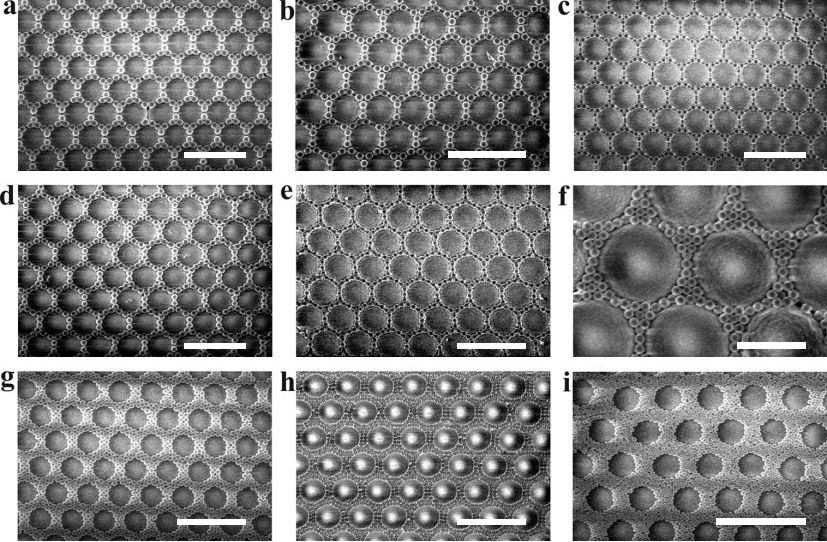Colloidal Lithography: A Versatile Technique for Nanoscale Patterning
Introduction to Colloidal Lithography
Colloidal lithography is a nanofabrication technique that utilizes colloidal particles as masks for creating ordered nanostructures on substrates. This cost-effective and scalable method has gained significant attention due to its ability to generate large-area periodic nanostructures with controllable size, shape, and spacing. Colloidal lithography offers a versatile platform for various applications, including photonics, plasmonics, and sensing.

Colloidal Mask Formation
The first step in colloidal lithography is the formation of a colloidal mask on the substrate. Colloidal particles, typically made of polystyrene, silica, or polymethyl methacrylate (PMMA), are self-assembled into ordered arrays through various techniques:
- Dip Coating: The substrate is vertically withdrawn from a colloidal suspension, allowing the particles to self-assemble on the substrate surface due to capillary forces.
- Spin Coating: A colloidal suspension is dispensed onto a spinning substrate, resulting in the formation of a uniform particle monolayer through centrifugal and evaporative forces.
- Langmuir-Blodgett Deposition: Colloidal particles are spread at the air-water interface and compressed to form a close-packed monolayer, which is then transferred onto a solid substrate.
The colloidal mask's quality depends on factors such as particle size, size distribution, and surface properties, which can be controlled to obtain the desired nanostructure arrangement.
Pattern Transfer
Once the colloidal mask is formed, the pattern is transferred onto the substrate through deposition or etching processes:
Deposition Techniques
- Physical Vapor Deposition (PVD): Materials such as metals or dielectrics are deposited onto the substrate through the interstitial spaces of the colloidal mask using techniques like evaporation or sputtering.
- Chemical Vapor Deposition (CVD): Gaseous precursors are introduced into a reaction chamber, where they decompose and deposit onto the substrate through the colloidal mask openings.
Etching Techniques
- Reactive Ion Etching (RIE): The substrate is exposed to a plasma containing reactive species that selectively etch the substrate material not protected by the colloidal mask.
- Ion Beam Etching (IBE): A collimated beam of ions is directed onto the substrate, physically sputtering away the exposed material while the colloidal mask acts as a protective layer.
After the deposition or etching step, the colloidal mask is removed, leaving behind the patterned nanostructures on the substrate.
Advantages of Colloidal Lithography
Colloidal lithography offers several advantages over conventional nanolithography techniques:
- Cost-Effectiveness: Colloidal lithography utilizes readily available colloidal particles and simple processing steps, making it a cost-effective alternative to expensive lithography tools.
- Large-Area Patterning: The self-assembly nature of colloidal particles enables the formation of periodic nanostructures over large substrate areas, which is challenging for conventional lithography methods.
- Tunability: The size, shape, and spacing of the resulting nanostructures can be easily tuned by controlling the colloidal particle size, deposition conditions, and post-processing steps.
- Compatibility: Colloidal lithography is compatible with a wide range of materials, including metals, semiconductors, and dielectrics, allowing for the fabrication of diverse nanostructures.
Applications of Colloidal Lithography
Colloidal lithography has found applications in various fields, leveraging its ability to create ordered nanostructures:
Photonics and Plasmonics
Colloidal lithography has been extensively used to fabricate photonic and plasmonic nanostructures, such as photonic crystals, plasmonic metamaterials, and optical antireflection coatings. These nanostructures exhibit unique optical properties, enabling applications in light manipulation, sensing, and energy harvesting.
Biosensing and Diagnostics
Nanostructures fabricated by colloidal lithography have been employed in biosensing platforms for the detection of biomolecules, such as proteins, DNA, and viruses. The periodic arrangement of nanostructures enhances the sensitivity and specificity of biosensors through localized surface plasmon resonance (LSPR) and surface-enhanced Raman scattering (SERS) effects.
Surface Functionalization
Colloidal lithography enables the creation of nanostructured surfaces with controlled wettability, adhesion, and biocompatibility. By tuning the size, shape, and spacing of nanostructures, surfaces with superhydrophobicity, superhydrophilicity, or selective cell adhesion can be obtained, finding applications in self-cleaning surfaces, microfluidics, and tissue engineering.
Challenges and Future Perspectives
Despite the significant progress in colloidal lithography, challenges remain in achieving perfect long-range order and precise control over individual nanostructure geometry. Efforts are being made to develop advanced self-assembly techniques, such as template-assisted self-assembly and directed self-assembly, to overcome these limitations.
Future research in colloidal lithography will focus on the integration of colloidal lithography with other nanofabrication techniques, such as nanoimprint lithography and electron beam lithography, to create hierarchical and multi-functional nanostructures. Additionally, the exploration of novel colloidal materials and the development of high-throughput, roll-to-roll processing methods will further expand the application scope of colloidal lithography.
Further Reading
Updates in Advanced Lithography, Colloidal Lithography
